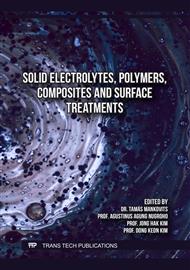[1]
Goro Suzuki, Tatsuya Nakamura, Takahiro Saito, and Shinji Tanaka: Global discharge of microplastics from mechanical recycling of plastic waste, Environmental Pollution, vol. 348, p.123855, 2024.
DOI: 10.1016/j.envpol.2024.123855
Google Scholar
[2]
Christian Meyer: The greening of the concrete industry, Cement Concrete Composite, vol. 31, no. 8, p.601–605, 2009.
DOI: 10.1016/j.cemconcomp.2008.12.010
Google Scholar
[3]
Khaled E. El-Aidy, Mohamed Ellithy, Mohamed H. Mahmoud, and Tarek F. El-Shafiey, Mechanical and physical properties of eco-friendly recycled plastic concrete (RPC)," Journal of Building Engineering, vol. 97, p.110907, 2024.
DOI: 10.1016/j.jobe.2024.110907
Google Scholar
[4]
Shuai Chen and Yonghua Hu, Advancements and future directions in waste plastics recycling: From mechanical methods to innovative chemical processes, Chemical Engineering Journal, vol. 493, p.152727, 2024.
DOI: 10.1016/j.cej.2024.152727
Google Scholar
[5]
Muhammad Rabnawaz, Ian Wyman, R. Alexander Auras, and Shu Cheng, A roadmap towards green packaging: the current status and future outlook for polyesters in the packaging industry, Green Chemical, vol. 19, no. 20, p.4737–4753, 2017.
DOI: 10.1039/C7GC02521A
Google Scholar
[6]
Lea Helm, Emily Murphy, Alison McGivern, and Shannon Borrelle, Impacts of plastic waste management strategies, Environmental Reviews, vol. 31, Aug. 2022.
DOI: 10.1139/er-2021-0117
Google Scholar
[7]
Ranjan Tuladhar and Shu Yin, 4 - Production of recycled polypropylene (PP) fibers from industrial plastic waste through melt spinning process, in Use of Recycled Plastics in Eco-efficient Concrete, F. Pacheco-Torgal, J. Khatib, F. Colangelo, and R. Tuladhar, Eds., in Woodhead Publishing Series in Civil and Structural Engineering, Woodhead Publishing, 2019, p.69–84.
DOI: 10.1016/B978-0-08-102676-2.00004-9
Google Scholar
[8]
Hyosung Chemical, "Official Website," Available: https://www.hyosungchemical.com/kr, Dec. 10, 2024.
Google Scholar
[9]
Willem C. J. Zuiderduin, Diederik S. Homminga, Herman J. Huétink, and Rogier J. Gaymans, Influence of molecular weight on the fracture properties of aliphatic polyketone terpolymers, Polymer (Guildf), vol. 44, no. 20, p.6361–6370, 2003.
DOI: 10.1016/S0032-3861(03)00635-9
Google Scholar
[10]
Osamu Ohsawa, Kwang-Hyun Lee, Byoung-Soo Kim, Sung Lee, and Ik-Soo Kim, Preparation and characterization of polyketone (PK) fibrous membrane via electrospinning, Polymer, vol. 51, no. 9, p.2007–2012, 2010.
DOI: 10.1016/j.polymer.2010.02.045
Google Scholar
[11]
Arjan A. Smaardijk and Erik Drent, Polyketones: Aliphatic, Encyclopedia of Materials: Science and Technology, K. H. J. Buschow, R. W. Cahn, M. C. Flemings, B. Ilschner, E. J. Kramer, S. Mahajan, and P. Veyssière, Eds., Oxford: Elsevier, 2001, p.7194–7196.
DOI: 10.1016/B0-08-043152-6/01277-8
Google Scholar
[12]
Hui Lin, Chengyuan Liu, Yong Wang, and Xue Zhang, Influence of hygrothermal conditioning on the chemical structure and thermal mechanical properties of aliphatic polyketone, Polymer Degradation and Stability, vol. 179, p.109260, 2020.
DOI: 10.1016/j.polymdegradstab.2020.109260
Google Scholar
[13]
Woon-Sang Bae, Sung Lee, and Bum Chul Kim, Effect of shear condition on the thermal stabilization of ethylene–propylene–carbon monoxide terpolymer, Polymer Degradation and Stability, vol. 105, p.160–165, 2014.
DOI: 10.1016/j.polymdegradstab.2014.04.001
Google Scholar
[14]
George Wypych, PEKK polyetherketoneketone, in Handbook of Polymers, Second Edition, George Wypych, Ed., ChemTec Publishing, 2016, p.380–382.
DOI: 10.1016/B978-1-895198-92-8.50117-8
Google Scholar
[15]
Erik Drent, Johan A. M. Van Broekhoven, and Michael J. Doyle, Efficient palladium catalysts for the copolymerization of carbon monoxide with olefins to produce perfectly alternating polyketones, J Organomet Chemistry, vol. 417, no. 1, p.235–251, 1991.
DOI: 10.1016/0022-328X(91)80176-K
Google Scholar
[16]
K. Chaitanya, Molecular structure, vibrational spectroscopic (FT-IR, FT-Raman), UV–vis spectra, first order hyperpolarizability, NBO analysis, HOMO and LUMO analysis, thermodynamic properties of benzophenone 2,4-dicarboxylic acid by ab initio HF and density functional method, Spectrochimica Acta Part A: Molecular and Biomolecular Spectroscopy vol. 86, p.159–173, 2012.
DOI: 10.1016/j.saa.2011.09.069
Google Scholar
[17]
Simone A. Bortolato, Kenneth E. Thomas, Kenneth McDonough, Richard W. Gurney, and David M. Martino, "Evaluation of photo-induced crosslinking of thymine polymers using FT-IR spectroscopy and chemometric analysis," Polymer (Guildf), vol. 53, no. 23, p.5285–5294, 2012.
DOI: 10.1016/j.polymer.2012.09.007
Google Scholar
[18]
Tao Lu, Eduardo Solis-Ramos, Yuan Yi, and M. Kumosa, UV degradation model for polymers and polymer matrix composites, Polymer Degradation and Stability, vol. 154, p.203–210, 2018.
DOI: 10.1016/j.polymdegradstab.2018.06.004
Google Scholar
[19]
John P. Beaumont, 2 - Rheology and Melt Flow in an Injection Mold, Runner and Gating Design Handbook (Third Edition), Third Edition, John P. Beaumont, Ed., Hanser, 2019, p.7–32.
DOI: 10.3139/9781569905913.002
Google Scholar
[20]
Richard J. Crawford and Paul J. Martin, Chapter 5 - Analysis of polymer melt flow," in Plastics Engineering, Fourth Edition, Richard J. Crawford and Paul J. Martin, Eds., Butterworth-Heinemann, 2020, p.411–488.
DOI: 10.1016/B978-0-08-100709-9.00005-4
Google Scholar
[21]
Peter Larkin, Chapter 1 - Introduction: Infrared and Raman Spectroscopy, Infrared and Raman Spectroscopy, Peter Larkin, Ed., Oxford: Elsevier, 2011, p.1–5.
DOI: 10.1016/B978-0-12-386984-5.10001-1
Google Scholar
[22]
Ruhul Kizil and Jeyaraj Irudayaraj, Chapter 6 - Spectroscopic Technique: Fourier Transform Raman (FT-Raman) Spectroscopy, Modern Techniques for Food Authentication (Second Edition), Second Edition, D.-W. Sun, Ed., Academic Press, 2018, p.193–217.
DOI: 10.1016/B978-0-12-814264-6.00006-2
Google Scholar
[23]
Victor S. Escribano, Carlos del Hoyo Martínez, Eduardo Fernández López, Juan M. Gallardo Amores, and Giuseppe Busca, Characterization of a ceria-zirconia-supported Cu oxides catalyst: An FT-IR study on the catalytic oxidation of propylene, Catalysis Communications, vol. 10, no. 6, p.861–864, 2009.
DOI: 10.1016/j.catcom.2008.12.024
Google Scholar
[24]
Peng He, Xiaoyang Zhao, Ling Wang, and Zhen Xu, Thermal degradation of syndiotactic polypropylene and the influence of stereoregularity on the thermal degradation behaviour by in situ FTIR spectroscopy, Polymer Degradation and Stability, vol. 88, no. 3, p.473–479, 2005.
DOI: 10.1016/j.polymdegradstab.2004.12.008
Google Scholar
[25]
Xiao Chen, Meng Xu, Ling Yuan, Guang Huang, Xiaoqiang Chen, and Wen Shi, Degradation degree analysis of environmental microplastics by micro FT-IR imaging technology, Chemosphere, vol. 274, p.129779, 2021.
DOI: 10.1016/j.chemosphere.2021.129779
Google Scholar



